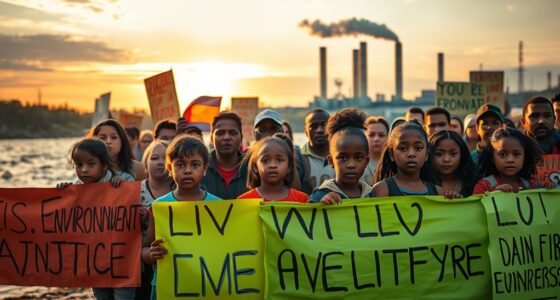Contemporary art serves as a powerful tool for human rights advocacy, turning raw images and visual stories into emotionally impactful messages. Through public art, murals, and participatory projects, artists challenge injustice, raise awareness, and inspire action across communities. Ethical concerns and cultural considerations shape how art addresses sensitive topics. By exploring these creative approaches, you’ll discover how art influences public opinion and fosters social change—continue exploring to learn how these strategies make a lasting impact.
Key Takeaways
- Contemporary art uses visual storytelling and powerful imagery to raise awareness and evoke emotional responses around human rights issues.
- Artists leverage public spaces and participatory projects to foster community engagement and promote social justice.
- Ethical considerations are vital in creating advocacy art, ensuring respectful, truthful representations of marginalized groups.
- Digital media and interactive installations amplify messages, making human rights advocacy accessible and engaging globally.
- Cross-cultural collaborations enhance the impact of social justice art by blending diverse perspectives and fostering global solidarity.
The Power of Visual Narratives in Human Rights

Have you ever wondered how a single image can change the course of human rights awareness? Visual narratives possess a unique power to evoke emotion and drive action. A powerful photograph or artwork captures raw, honest moments that words often can’t express. These images can expose injustice, human suffering, and resilience, making distant issues feel personal. They cut through apathy, prompting viewers to reflect and act. Social movements have historically relied on compelling visuals to rally support and influence public opinion. Because images transcend language barriers, they spread awareness rapidly across cultures and borders. When used intentionally, visual storytelling becomes a catalyst for change, inspiring empathy and mobilizing communities to demand justice. The effectiveness of these visuals is often enhanced by color accuracy, which ensures that the images convey their intended emotional impact. In this way, visuals become essential tools in the fight for human rights.
Artists as Activists: Bridging Art and Advocacy

Artists play a vital role in activism by transforming their creative talents into powerful tools for social change. You can leverage your art to raise awareness, challenge injustice, and inspire action. When you use your work as advocacy, you connect emotionally and intellectually with audiences, making difficult topics more accessible. Your involvement can take many forms:
- Creating provocative pieces that highlight human rights issues
- Participating in public art projects or murals
- Collaborating with advocacy groups for campaigns
- Using social media to share impactful images and messages
- Understanding support hours for related organizations can help plan your outreach efforts effectively.
Case Studies: Iconic Artworks and Human Rights Campaigns

Throughout history, powerful artworks have played a pivotal role in advancing human rights causes, capturing public attention and inspiring action. Take Picasso’s “Guernica,” which vividly depicts the horrors of war and the suffering of civilians, galvanizing anti-war sentiments worldwide. Another example is the “Fearless Girl” sculpture, which symbolizes gender equality and challenges corporate and societal norms. The photograph of “The Napalm Girl,” taken during the Vietnam War, shocked viewers and fueled anti-war movements. These artworks go beyond aesthetics; they serve as visual catalysts, raising awareness and mobilizing support. Their impact lies in their ability to communicate complex human rights issues instantly, making them timeless tools for advocacy. These case studies exemplify art’s power to influence public opinion and inspire tangible change.
The Role of Public Spaces in Promoting Awareness

Public spaces serve as vital platforms for raising awareness about human rights issues, offering a visible and accessible environment where messages can reach diverse audiences. When you engage with art in public areas, you help transform everyday spaces into powerful tools for advocacy. These environments encourage dialogue, reflection, and action. Incorporating visualization techniques into public art projects can enhance their impact by helping viewers connect emotionally with human rights themes, thereby fostering greater empathy and understanding.
Challenges and Ethical Considerations in Human Rights Art

As you create or share human rights art, you must consider your artistic responsibility and how your work might influence viewers. Maneuvering political sensitivities can be tricky, and you need to balance raising awareness with respecting diverse perspectives. It’s essential to think carefully about the ethical implications to guarantee your art promotes understanding rather than harm. Awareness of privacy and cookies regulations can also impact how your audience engages with your work online.
Artistic Responsibility and Impact
Creating human rights art carries significant responsibility, as artists must balance raising awareness with respecting the dignity of those depicted. You need to be mindful of how your work impacts viewers and subjects alike. Ethical considerations include obtaining consent, avoiding exploitation, and being truthful without sensationalizing suffering. Your impact can inspire change but also risk perpetuating stereotypes or trauma if misused. To navigate this responsibly, consider:
- Ensuring respectful representation of subjects
- Balancing emotional impact with accuracy
- Avoiding voyeurism or sensationalism
- Acknowledging your own biases and limitations
- Understanding divorce laws and how they influence perceptions of justice and fairness in society
Navigating Political Sensitivities
Dealing with political sensitivities in human rights art requires careful consideration of the complex and often contentious environments in which these works are presented. You need to understand the local context and the potential risks involved, including censorship, backlash, or even danger to yourself and others. It’s essential to strike a balance between raising awareness and respecting political boundaries. When creating or displaying your work, consider how it might be perceived by authorities, communities, and audiences. Ethical considerations include avoiding harm, misrepresentation, and exploitation. You must be prepared to adapt your approach if necessary, ensuring your message remains impactful without jeopardizing safety or integrity. Steering through these sensitivities demands thoughtful strategy, empathy, and a deep awareness of the geopolitical landscape. Additionally, staying informed about the evolving AI safety measures can help artists anticipate and mitigate potential technological risks to their work.

Digital platforms give you the power to amplify voices that might otherwise go unheard, making social justice issues more visible. Interactive art encourages your personal engagement, inspiring action and deeper understanding. Cross-cultural collaborations expand the reach of these messages, fostering global solidarity and change. Additionally, leveraging wealth of female singers can help fund initiatives that promote social justice through art and advocacy.
Digital Platforms Amplify Voices
As social media platforms continue to grow, they empower you to share your stories and advocate for justice more effectively than ever before. You can amplify marginalized voices, spotlight human rights abuses, and mobilize communities instantly. These platforms break down barriers, giving you direct access to global audiences and decision-makers. You can:
- Share compelling images and videos to raise awareness
- Organize online campaigns that reach millions
- Connect with activists and organizations worldwide
- Document events in real-time, ensuring transparency
This digital shift transforms activism from isolated acts into widespread movements. You become part of a larger conversation that can influence change, challenge oppressive systems, and foster solidarity across borders. The power of these platforms lies in their ability to amplify your voice and ignite collective action for social justice.
Interactive Art Drives Engagement
Interactive art is transforming social justice efforts by actively engaging audiences and encouraging participation. It invites you to become part of the message, making issues personal and immediate. This approach fosters empathy and understanding, turning viewers into advocates. You don’t just observe; you participate, shaping the experience and amplifying the cause. Here’s how different mediums create impact:
| Medium | Example | Impact |
|---|---|---|
| Interactive Installations | “The Truth Booth” | Sparks dialogue and community bonding |
| Digital Campaigns | Virtual reality exhibits | Immerses viewers in social issues |
| Participatory Art | Community mural projects | Builds collective ownership |
| Mobile Engagement | Social media challenges | Reaches wider audiences |
| Live Events | Protest art performances | Mobilizes immediate action |
Additionally, incorporating spiritual energy concepts like empathy and emotional resonance can deepen engagement and foster authentic connections around social justice issues.
Cross-Cultural Collaborations Expand Reach
Cross-cultural collaborations are expanding the reach of social justice art by blending diverse perspectives and artistic traditions. This fusion creates powerful messages that resonate across borders, fostering understanding and empathy. When artists from different backgrounds work together, they challenge stereotypes and highlight shared human experiences. These partnerships often lead to innovative visual storytelling that captures complex social issues. As a result, your audience gains a broader view of human rights struggles, encouraging global solidarity. Collaborations also increase visibility for marginalized voices, amplifying their stories worldwide. By uniting different artistic styles and cultural contexts, you help bridge gaps and inspire collective action. Developing cultural intelligence among artists and organizers further enhances these collaborations’ effectiveness. Ultimately, these collaborations strengthen the impact of social justice art, making it more accessible and compelling for diverse communities.
Frequently Asked Questions
How Do Artists Ensure Their Work Respects Cultural Sensitivities?
You guarantee your work respects cultural sensitivities by researching and understanding the traditions, values, and histories of the communities you depict. Engaging with community members and seeking their feedback helps you avoid misrepresentation or offense. You also remain open to critique, adjusting your work accordingly. By practicing empathy and cultural humility, you create art that honors diverse perspectives while communicating your message effectively.
What Funding Sources Support Human Rights-Themed Art Projects?
Imagine a garden where ideas blossom—funding sources like government grants, NGOs, and private foundations nurture human rights-themed art projects. You can also explore crowdfunding platforms and artist residencies that act as fertile soil for your creative activism. These sources provide the essential nutrients—financial support, resources, and visibility—helping your work grow strong and impactful, spreading the message of human rights far and wide like a vibrant, unstoppable vine.
How Is the Effectiveness of Art-Based Advocacy Measured?
You measure the effectiveness of art-based advocacy by tracking audience engagement, such as attendance, social media interactions, and media coverage. You also evaluate whether the artwork sparks conversations or influences policy changes. Gathering feedback through surveys or interviews helps you understand if the message resonates. Ultimately, you look for tangible shifts in public awareness or behavior that indicate your art has successfully advanced human rights awareness.
Can Art Influence Policy Change in Human Rights Issues?
Absolutely, art can influence policy change in human rights issues. Your powerful pieces provoke politicians, push policymakers, and spark public pressure. When you create compelling visuals and messages, you inspire action, ignite debates, and influence legislation. Art’s emotional impact often cuts through bureaucracy, making complex issues relatable. By engaging audiences and amplifying voices, your art can sway policymakers and foster tangible change in human rights policies.
What Training or Resources Are Available for Artists Working on Social Justice?
You can access numerous training programs and resources for social justice art. Look into workshops offered by organizations like Creative Capital or the National Endowment for the Arts, which focus on activism and advocacy. Online platforms such as Coursera and edX offer courses on art and social change. Additionally, connect with local art collectives and advocacy groups for mentorship, collaboration, and ongoing support to enhance your skills and impact.
Conclusion
As you step back, see art as a lantern guiding awareness through shadows of injustice. Each bold brushstroke and silent sculpture becomes a beacon, illuminating truths that demand change. Remember, your voice can be the spark that ignites this luminous journey—where creativity transforms darkness into hope. Embrace the power of visual stories, for in their light, human rights find a resilient, unstoppable voice.









